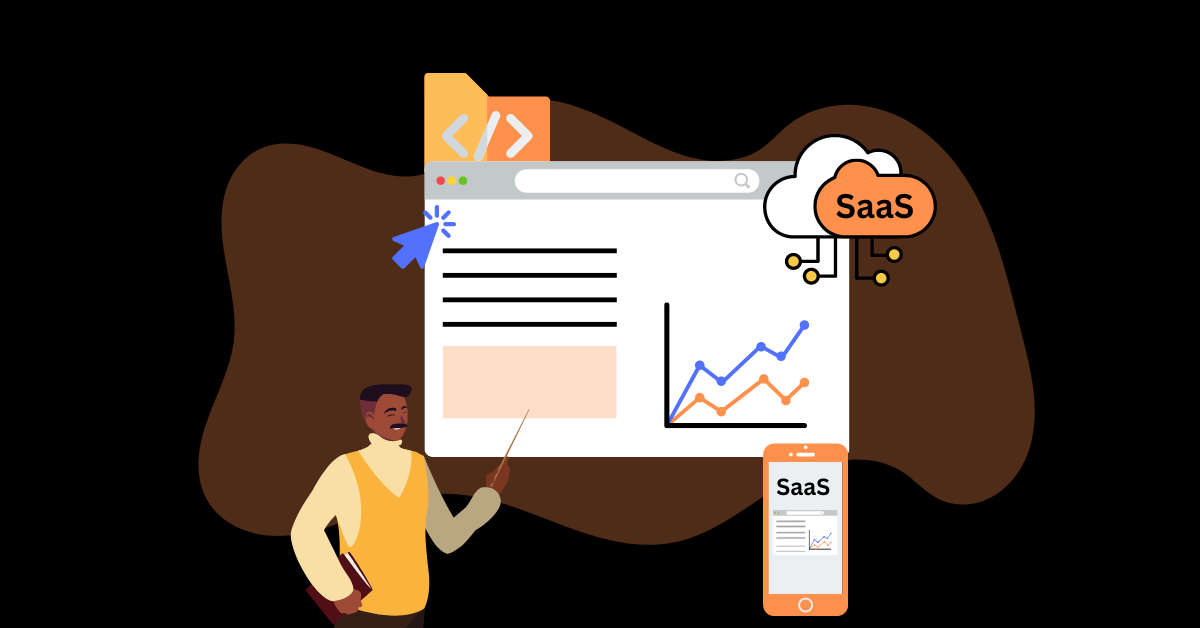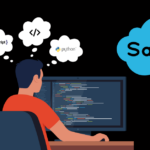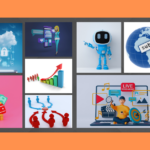So you’re thinking you want to learn how to design a SaaS product in 2024. Yes, it can initially seem intimidating. Yes, it’s going to be a metric ton of work.
It also provides an exciting opportunity for the right entrepreneur. You can innovate in a technological landscape that’s constantly evolving.
With more than 30,000 SaaS companies in the world as of right now, industry professionals expect that figure to more than double by the end of 2024. The market will be fierce. You’ll want to do everything possible to stand out and make your product the best in class.
The current era of SaaS development is characterized by the prevalent use of cloud-based solutions. And now, we can add the exploration of machine learning capabilities into the mix.
These points and an unprecedented shift toward a remote working culture revolutionize our approach to building new companies.
We wanted to take some time and build a comprehensive guide for the newcomers. The ones who are now discovering SaaS and everything it offers the world.
Let’s lay out some of the fundamental principles of creating a SaaS product. We’ll emphasize user-friendly interfaces, scalable architecture, and strategies to ensure its success. LFG.
Table of Contents
How to Design a SaaS Product in 2024: What Makes a Great Product?

Venturing into the specifics of how to design a SaaS product in 2024 requires a solid understanding of distinguishing features. It’s that extra something that separates an exceptional SaaS product from an average one.
If you want to be next on our list of the best B2B SaaS marketing campaigns, there are three significant elements you should keep in mind at all times:
Prioritizing User-Centric Design
Adopting a user-centric approach places the needs of users at the forefront of your business.
It entails knowing their challenges and issues. Your job is to take on the task of making intuitive interfaces that make navigation effortless.
Build a foundation of trust with customers. A successful SaaS company will have continuous user feedback coming in.
The feedback will help devs and engineers make changes and add new features. The changes and new features will augment and refine the customer experience.
Scalability in Focus
Your SaaS product should have the capacity to expand and adjust according to the demands.
Keep scalability in mind. Before establishing a company structure or writing a single line of code, you should have a clear idea of how you can scale.
How are you going to collect data? How will you handle the vast amounts available? How will you accommodate a growing user base? How will you allocate revenue in various parts of the pre and post-launch phases?
Knowing the answers to these questions before you build your product will help you build the product.
Articulating a Clear Value Proposition
A solid SaaS product conveys a lucid value proposition to its target audience.
The value proposition can take various forms. It could mean alleviating a pain point. It could be making business processes more efficient. Or maybe it means presenting a distinct solution that provides a competitive edge in the market.
Ideally, you want to tag all three, right?
Also, the value proposition has to resonate with the potential users and convince them of the product’s worth.
Try breaking this down into a short sales pitch. Practice the pitch on friends and family. If they can’t “get in” in that amount of time, keep working on it. You need to be able to break down what you do and why you’re the best really quickly.
Your customers will be busy people who receive a lot of offers and cold pitches. Know how you’re going to stand out.
What Are the Types of SaaS Products?

SaaS products have a capacity for a diverse range. They can carry distinctive traits and cater to a different audience.
When learning how to design a SaaS product, find the essence of the product category. It can significantly influence design choices. Here are a few of those categories. There are more that we aren’t listing and subcategories of the ones we do have.
Use this guide as a starting point.
Vertical SaaS
These SaaS offerings are custom-made for individual industries or niche markets. They deliver specialized solutions that meet their unique requirements.
Vertical SaaS products typically serve a smaller, focused customer base. Given their targeted nature, they can command higher prices. The appeal of these products lies in their industry-specific functionality and deep domain expertise.
For example, your uncle is an attorney. He’s constantly complaining about X. He says all his lawyer buddies have the same problem. You set out to fix this problem. You talk to him and his lawyer friends, and they all agree it would be the solution they need.
You build a SaaS product for attorneys. That’s a vertical SaaS product, as businesses not in the legal space won’t get full value out of the product.
Horizontal SaaS
Horizontal SaaS products have a wide scope, serving multiple industries and various use cases.
These are often more budget-friendly and can tap into a larger potential customer base. But they also face intense competition due to their wider market application.
The best horizontal products provide broad, flexible solutions that are adaptable across different industries. SaaS solutions like Salesforce and Zendesk fall into this category.
Infrastructure as a Service (IaaS)
IaaS products are the backbone of the cloud-based services world.
They offer essential infrastructure services and resources in the cloud. These typically include things like:
- Servers
- Storage
- And networking components
These are pivotal for building SaaS products. But they can also stand alone as services for companies requiring flexible, scalable infrastructure solutions.
Major corporate solutions like Amazon’s AWS and Microsoft Azure fit this category.
Platform as a Service (PaaS)
PaaS offerings serve as a comprehensive platform for developers. It allows them to construct, deploy, and oversee their applications.
PaaS is particularly appealing to organizations with limited development resources. It offers a stable, ready-to-use environment to develop and run their solutions without the need for substantial internal infrastructure.
Google App Engine and Adobe Commerce would fall into this category.
As you can probably guess, there’s a reason most startups shoot for SaaS categories and not IaaS and PaaS. The corporate big boys hold most of the market share, and getting invited to that club can be difficult.
But, if your idea is stellar and you offer something they don’t, go for it.
Key Considerations for SaaS Product Design

As we delve deeper into the essential elements of how to design a SaaS product for 2024, you’ll want to keep these points top of mind:
Embracing the Cloud
Designing your SaaS product with a cloud-centric approach is non-negotiable. Older software models have become completely obsolete.
Harness the potential of cloud services. Your company will enhance scalability, fortify reliability, and drive cost-effective solutions.
It’s about ensuring your product can scale with customer demand. You want to guarantee uninterrupted service delivery. A key selling point will be your ability to maintain affordability using the pay-as-you-go model many cloud providers offer.
Optimizing for Mobile
Everyone has smartphones and tablets. The vast majority of people use them for research and shopping. Business and pleasure.
Conceive your SaaS product with mobile-friendliness in mind. Optimizing for these devices entails developing responsive designs that adapt to different screen sizes and user behaviors.
It also requires striking a balance between aesthetic appeal and functional simplicity. This fine line using technical SEO for SaaS websites is what provides a seamless mobile experience.
Prioritizing Data Privacy and Security
Incorporating robust security measures into your product design is paramount. Data breaches are in the news all too often. IT professionals and company decision-makers now prioritize security.
Customers expect products to adhere to industry-standard security protocols. This includes end-to-end encryption. Compliance with data privacy laws will protect user data and build customer trust.
Leveraging AI and Machine Learning
The terms artificial intelligence and machine learning still scare some people. But that doesn’t change the fact that they want automation. They want things to be easier. They want to unload their plates. And AI is the best way to do it.
AI and machine learning technologies offer a wealth of opportunities for SaaS product design.
Consider how your business will integrate these cutting-edge technologies into your product to enrich its functionality.
This tech can contribute significant value. It can automate routine tasks and personalize the user experience. It can use predictive analytics to anticipate user needs and drive proactive decision-making.
But, since you’ve decided to learn how to design a SaaS product, why not get ahead of the curve and learn how AI can help you, too?
How to Design a SaaS Product in 2024: Let’s Build One From Scratch
You want to learn how to design a SaaS product in 2024. We ain’t hatin’. It’s a great plan. And we’re here for it!
SaaS offers a level of convenience and scalability that traditional software can’t match. But, developing a SaaS product from scratch is complex. And owning your own business will be stressful at times.
So we’re going to walk you through every stage of the process, from initial concept and design all the way through to launch and ongoing management. Let’s bring your product to life.
Understanding the SaaS Model
The SaaS model offers several advantages over traditional software, such as lower upfront costs, automatic updates, and easier scalability.
When building a SaaS product, remember these key elements:
- Accessibility
- Scalability
- And, subscription-based pricing
Prioritizing these factors in your product development makes your SaaS offering deliver on its promises and stand out in the competitive market.
Getting Started: From Idea to MVP
The first step in building a SaaS product is coming up with a winning idea. This involves identifying a problem or pain point your target audience faces and developing a solution.
Once you have a solid concept, it’s time to create a Minimum Viable Product (MVP). An MVP is a basic version of your product that contains only the core features.
TLDR: It’s an operational prototype.
It allows you to test your idea and gather feedback from potential users without investing too much time and money upfront.
Focus on the essentials here. Resist the urge to add in every feature that comes to mind that you think people might want. Get the damn thing on the market.
The longer you wait, the more time a competitor has to beat you to the market, and the more resources you burn without having any revenue.
Getting your MVP together quickly and efficiently will help keep development costs low and prevent feature bloat. Minimizing these factors will allow you to gather user feedback and refine your product before investing in additional features.
Identifying a Market Need for Your SaaS Product
Even with a great idea and a solid MVP, your product won’t succeed if there isn’t a market need for it. This is often called SaaS product market fit.
Conduct thorough market research to validate your idea and ensure that there is demand.
Determining your PMF involves:
- Identifying your target audience
- Understanding their pain points and needs
- And researching competitors in the market
It’s pretty traditional in many ways to how businesses have figured out if and how a new company would fit into the overall market. But now, there is an extreme amount of data available to you.
Gathering data and insights from potential users will refine your product to better meet their needs.
There is no point in pursuing the idea any further unless you find a gap in the market that your product can fill. Identifying your PMF will give you a solid foundation and a higher chance of success.
Creating an Effective Business Plan

Once you have a validated idea and an MVP in place, it’s time to start thinking about the business side of your SaaS product.
Create a comprehensive business plan that outlines your goals:
- Financial Projections: Include anticipated revenues, expenditure, and profit margins. Try to make these projections as realistic as possible.
- Pricing Strategies: Determine your pricing model. Will you offer a tiered pricing structure? Or a freemium model? Carefully consider what will appeal to your target market while ensuring profitability.
- Customer Acquisition and Retention Plans: Detail how you plan to attract new customers and keep existing ones. This could involve strategies like SaaS digital marketing strategies, following SaaS customer support best practices, and creating a great SaaS referral program.
- Operational Strategy: What are your plans for product development? Team structure? B2B SaaS go-to-market strategy? What are your plans for scaling the business as it grows? You need to know the answers for yourself. But investors will want to know them as well.
A strong business plan helps you stay focused and organized throughout the development process and serves as a roadmap for future growth and success.
A robust business plan acts as a dual-purpose tool.
On one hand, it assists in maintaining focus and organization during the development phase. It also operates as a navigational chart for future expansion and triumph.
Defining Your SaaS Product’s Unique Value Proposition
Every business needs to have a unique value proposition that sets it apart from the competition. It doesn’t matter if you’re a one-person SaaS machine or an enterprise-level solution.
It could be a specific feature, pricing model, or target audience.
You can attract and retain users by defining your product’s unique selling points. The second step is being able to communicate those points clearly to your audience.
Consider what sets your product apart. Why should users choose it over other options?
Planning and Designing Your SaaS Product
It’s time to start planning and designing your SaaS product.
At this stage, you should already have a detailed roadmap. It should be made up of part business plan, part market analysis, and your UVP.
Use it as a guide for development, setting milestones, and determining the technologies and tools you will use.
When designing your product, keeping user experience (UX) in mind is a must.
A well-designed UX can make or break a SaaS product. It directly impacts user satisfaction and retention.
This step also involves creating wireframes, mockups, and more prototypes to visualize your product and gather feedback from potential users.
Assembling Your SaaS Development Team
Building a SaaS product from scratch requires a diverse, skilled team. As you have a product framework in place and a vision for your company, you now need a group of people who buy into it and believe in what you’re trying to do.
A SaaS team will be comprised of:
- Developers
- Designers
- Marketers and a sales team
Carefully consider each team member’s skills and experience to ensure that they are the right fit for your project.
In addition to technical expertise, team members should have strong communication skills and be able to work collaboratively.
A cohesive group will keep the development process running smoothly. It will be easier to keep everyone on the same page all the way through until launch. You’ll need skilled project managers to keep this team collaborating and working towards the company goals.
What Is SaaS Product Management?

Knowing what is SaaS product management is knowing, living, and breathing your vision and your unique value proposition.
SaaS product management involves overseeing the development and launch of a SaaS product. It’s a role that requires strong project management skills, as well as an understanding of both the technical and business aspects of a SaaS product.
Product managers are responsible for:
- Setting goals and defining a roadmap for the product
- Overseeing the development process to ensure it aligns with the product vision
- Conducting market research and gathering feedback from potential and existing users
- Analyzing data and using insights to make informed decisions about the product’s direction
- Collaborating with cross-functional teams to ensure a seamless launch and ongoing product success.
Choosing the Right Tech Stack for Your SaaS Product
Selecting the right technologies and tools for your SaaS product is necessary for success.
You’ll need to decide on the programming languages you want to use. Back-end frameworks. Front end. Data and storage. The list goes on.
On top of that, you’ll have to decide on a project management software like Asana or Notion. Slack or Discord? Most of your team will be remote, so you want to have everything planned out beforehand.
When choosing a tech stack, take scalability, security, and maintenance into account. Evaluate all available options and seek expert advice if needed.
Finding the tech stack that best suits your product’s needs will be worth it in the long run.
Developing Your SaaS Product
Once all the planning and preparation are complete, it’s time to start developing your SaaS product.
Everyone will be on the grind at this stage. They’ll be busy coding, testing, and analyzing data.
Be agile and adaptable. Unexpected challenges may arise along the way.
Regularly communicate with your team and stay open to feedback. Your product will stay fluid, constantly improving and meeting the needs of your target audience.
Testing Your SaaS Product
I say, “Bay”. You say, “Tuh”.
Bay.
Tuh.
Bay.
Tuh.
That’s right. We’re officially in Beta testing season at this stage.
Before launching your SaaS product, it’s important to thoroughly test it for bugs, usability issues, and overall functionality.
This step involves conducting various tests, such as unit and integration testing. Eventually, you’ll move on to user acceptance testing.
Testing is a crucial part of the development process. You catch any issues before they reach your users. It also keeps your product at the high standards of quality expected in today’s market.
Preparing for Product Launch

With development and testing complete, it’s time to start preparing for the launch of your SaaS product.
You’ll need to start thinking about the following:
- Creating a marketing strategy
- Setting up a payment system
- Establishing customer support channels
- And building a community engagement plan
A successful SaaS product launch marketing plan requires effective communication and planning across all aspects of your business. It will likely be the most hectic time your company has ever experienced.
But it’s worth it.
Engaging with potential customers and building hype around your product before its release will increase the chances of a successful launch.
What Is SaaS Product Marketing?
Coders gonna code. One thing coders (and most people, for that matter) don’t fully understand when they start their company is the importance of marketing.
What is SaaS product marketing?
It’s the key to the ongoing success of your business.
The first step is creating a strong online presence. You’ll use a blend of SaaS social media marketing and content writing for SaaS.
While that wheel is turning, you must also keep other wheels turning. They’re all a part of the same machine. You should still be gathering user feedback and working on product improvements.
Stay updated on current marketing trends and adapt to keep your product relevant.
Using marketing to promote your product will keep you engaged with customers. Do whatever works. This is part of your user feedback wheel.
Where are they? What channels do they want you to use? If they like social media content, why waste your time with email?
Focus on value and delivering more of it each and every day. Providing value will build a loyal user base and drive long-term success.
Managing Post-Launch Operations and Maintenance
Launching your SaaS product is just the beginning of its journey.
Your strategies will change, evolve, and mature depending on your current phase.
Building awareness of your product will have one set of tactics. Creating hype pre-launch will have another set. And what your SaaS post-product launch marketing plan looks like will have a completely different set.
Have a plan in place for managing every phase of your operation. Preparedness will keep your product running smoothly and provide value to users even as you pivot to varying methods of promotion.
To accomplish this,
- Track performance metrics
- Address any issues that arise promptly
- Update and improve your product based on user feedback
- Stay proactive and responsive
Scaling Your SaaS Product
As your SaaS product gains popularity and attracts more users, develop a plan for scaling.
You may need to look into increasing server capacity. Hiring additional team members is probably a given. You may even consider expanding into new markets.
The devil is in the details.
Carefully examine the potential impacts of scaling on your product and business operations.
Don’t plan to fail. Don’t ask yourself “What if”. Plan for success and growth from the jump.
Measuring Success and Key Performance Indicators (KPIs)
Measuring the success of your SaaS product is an ongoing process that involves tracking key performance indicators (KPIs).
This could include metrics such as
- User acquisition
- Churn rate
- Revenue
- And, customer satisfaction
By regularly monitoring these KPIs and performing a SaaS marketing audit, you can gain valuable insights into the health of your product.
The information will guide future decisions and improvements to the product and the company. Data-driven decision-making is the future of business. So start early.
How to Design a SaaS Product in 2024 – Not as Simple as You Thought?

Knowing how to design a SaaS product in 2024 is only part of the process. The evolution from concept to launch and even post-launch is an incredible journey with ups and downs. It will be a learning experience full of business and life lessons.
Each stage, be it development, testing, product launch, marketing, or managing post-launch operations, warrants strategic and thoughtful execution.
It begins with asking yourself many questions and then finding the answers.
- Is there a need for this product in the market?
- What is SaaS product management?
- What makes this product different?
- How do I build it?
- Who do I need to hire? When should I hire them? Why do I need them?
- What is SaaS product marketing?
These are not roadblocks. Thinking is not stopping. Exploring options isn’t a setback. Every part of this path is a step you need to take to find success.
To help you along while you’re still wearing all the hats, check out these SaaS digital marketing automation tools to help you along.
And remember to keep visiting LMC and reading our content. We’ll help you get the head start you need to build your products and construct a successful business.




